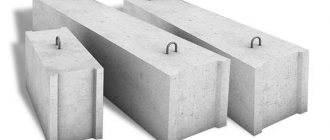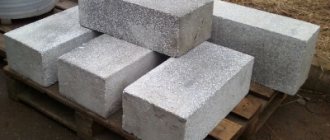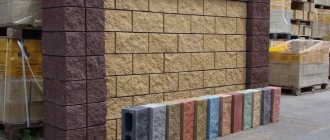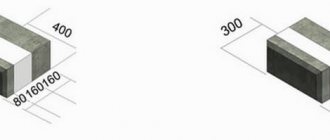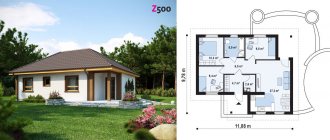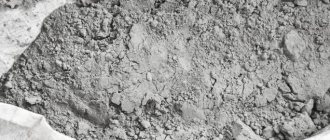A universal and common material for low-rise construction is blocks made of cement and sawdust. The main advantage is the low cost of the product. Other advantages are: ease of self-production, high strength of the final structure and ease of use. Building blocks made from sawdust and cement have high technical and operational characteristics: effective noise insulation, increased thermal insulation, resistance to frost and seismic activity.
Sawdust concrete blocks - characteristics
Sawdust blocks are a lightweight material for building structures up to 2-3 floors. It belongs to a variety of cement products, but is lightweight. The unique properties of the substance contribute to its use in cold regions, and is sometimes used as a sound-proofing or heat-insulating layer.
Building blocks made of sawdust and cement
Let's take a closer look at the product characteristics:
- heat preservation. In structures made from sawdust concrete blocks it is easy to maintain any temperature, both cold (for warehouses, small industries) and warm (for residential premises);
- environmental cleanliness. In blocks made of cement and sawdust, exclusively natural and natural raw materials are used;
- high structural strength. The completed building has sufficient stability and reliability;
- fire resistance. Thanks to a special technology for the production of sawdust blocks, the material is fire resistant;
- the house “breathes”. The “breathing” effect is due to the property of allowing steam to pass through, which helps maintain a favorable microclimate;
- resistance to temperature changes. Buildings that use sawdust concrete as a building material are not subject to cracking or settling after freezing and thawing. The blocks can withstand repeated cycles of freezing and freezing;
- low cost. Thanks to the use of inexpensive raw materials, it is possible to significantly reduce the cost of building a house.
Based on specific gravity, there are 2 main types of products:
- thermal insulation, its density is 400-800 kg/m3;
- structural with a specific gravity from 800 kg to 1.2 t per m3.
Sawdust blocks are a lightweight material for building structures up to 2-3 floors.
Increased performance characteristics lead to the increased popularity of blocks using cement and wood. There is another type of wood with concrete - wood concrete. The characteristics of wood concrete blocks are superior to sawdust concrete, since they use special chips of a fixed size and a larger amount of wood.
Comparing both materials, wood concrete retains heat better, has increased ductility (withstands greater bending load) and optimal air permeability. The production of blocks from sawdust implies a content of 50% wood, and in wood concrete - 80-90%. Most wood concrete blocks are used for the construction of residential premises.
What is sawdust concrete and where is it used?
The material is based on durable grades of cement. When mixed with sand, mineralizers, and sawdust, this building material is obtained, which is highly versatile. Today, a variety of designs are made from it, and also used for insulation purposes. But the main range of application, of course, is low-rise private construction. At the same time, sawdust concrete is used both for the construction of residential buildings and for the construction of adjacent buildings and structures.
Grades M5 and M10 are not strong enough for construction and are used for insulation purposes. As for the M15 and M20 grades, they are strong enough for the construction of houses.
Important! The more organic component there is in such concrete, that is, sawdust, the lower its strength, but at the same time the higher its insulating qualities. That is why this material is used for insulating basements and other already constructed premises. With an increase in the proportion of sand and concrete, not only strength increases, but also water resistance and frost resistance. These types of materials are good at preventing corrosion of reinforcing elements.
Making blocks from sawdust and cement: main components
Sawdust is used to fill voids in cement. The variety of trees from which the base is taken is not regulated by law. Experts prefer deciduous and coniferous varieties. If the region of residence is characterized by an unfavorable atmosphere and harsh climate, it is better to prefer options for blocks with pine needles, they are more stable.
Portland cement, sand, and water are used as binders. To reduce the consumption of the binder component, lime or clay is sometimes added to the composition. Based on the ratio of the number of components, the final technical parameters of the product are determined. If the production of sawdust blocks is deprived of part of the sand, the material will become less dense and lighter, and the thermal insulation properties will also increase, a similar condition applies to wood concrete. The downside is the reduction in strength.
Portland cement PC І 500 for the production of blocks
If, when laying blocks of cement and wood chips, a person does not pursue the maximum increase in thermal insulation, but he values strength, the amount of sand is increased. As its dosage increases, reliability, durability, and resistance to frost and moisture increase. It is recommended to increase the amount of sand when adding steel reinforcement to the structure, as the material will prevent the rapid onset of corrosion.
Composition of sawdust blocks
To make sawdust concrete blocks with your own hands, it is first useful to study the composition of the material, and then stock up on high-quality raw materials. The mixture for the manufacture of block elements consists of the following components:
- Portland cement;
- sand;
- wood chips;
- clay or slaked lime;
- water.
Sawdust for the manufacture of building materials is taken only from certain types of wood. To ensure that the product is of high quality and resistant to rotting and the proliferation of microorganisms, it is recommended to use wood chips obtained after processing the following coniferous trees:
- pine;
- fir;
- spruce.
But it is also permissible to use sawdust left after cutting such trees:
To make blocks, it is allowed to use wood chips after cutting trees such as birch, oak, and ash.
- poplar;
- hornbeam;
- beech;
- oak;
- ash;
- birch.
Blocks made of sawdust and cement - advantages and disadvantages
Making blocks from sawdust and cement has many advantages compared to heavy materials and other lightweight concrete. Main advantages:
- minimum weight. The lightness of the material ensures savings on the construction and reinforcement of the base. The cost of the foundation based on the calculation calculator sometimes indicates the possibility of reducing the estimate by 30-40%;
- high levels of noise insulation. Due to the presence of voids in the material, it becomes similar to noise-absorbing slabs. The blocks maintain a comfortable sound environment indoors and prevent noise from entering the street;
- increased thermal insulation leads to savings on coolants;
- environmental Safety. The naturalness of the raw materials provides protection against the penetration of toxins, radiation and other harmful fumes;
- ease of processing. The material is relatively soft and easy to cut or separate. The structure remains dense, there is no negative impact after cutting, the material is still intact and durable;
- low price. Sawdust is present in abundance at any woodworking enterprise;
Blocks made of sawdust and cement are an environmentally friendly material
- ease of use. The blocks are relatively large in size, but light. Sawdust concrete walls are built faster;
- durability. Subject to compliance with the manufacturing and construction rules, the building will last from 50 to 80 years.
The presence of wood in the composition should make the material easily flammable, but due to the special production technology, the blocks are resistant to fire. During experimental tests, it was found that a structure made of sawdust concrete can easily withstand being under a fire for 2.5 hours without losing its performance properties. The material can withstand temperatures of 1100°C.
The use of shavings and wood chips leads to some disadvantages:
- Making blocks from cement and sawdust with your own hands requires a lot of time. The production cycle takes up to 3 months from the moment the mold is filled;
- the material absorbs moisture. Additionally, sawdust concrete needs protection from moisture from the outside and inside;
- The composition and characteristics of the sawdust greatly influence the final performance. It is recommended to use only sawdust with a low sugar concentration, as the substance accelerates decomposition and has a destructive effect on the product.
Having assessed the pros and cons, many builders prefer a lightweight type of concrete with sawdust or wood chips. Choosing sawdust concrete is the right decision in favor of saving.
Scope of application of sawdust and cement blocks
The material is most often used for the construction of low-rise buildings. Considering the production technology and dimensions of the product, it is excellent for the construction of:
- garages;
- dacha;
Scope of application of sawdust and cement blocks
- townhouses;
- internal partitions;
- cottages;
- cellars;
- insulating layer;
- buildings for domestic use;
- sometimes used to form foundations.
The composition of the mixture is based on the optimal characteristics of resistance to moisture, temperature and mechanical damage. Sawdust still tends to absorb water, therefore, when used in places with high humidity, it is recommended to install an additional layer of insulation. If the construction and manufacturing rules are followed, the blocks retain their correct shape and original characteristics for a long time. Buildings made of sawdust concrete practically do not need restoration for decades.
Selecting a room
To start sawdust processing as a business, you will need a spacious room with an area of at least 120 square meters. m. The building must have:
- a large workshop in which the production line will be installed;
- storage space for sawdust and finished products;
- equipped office;
- bathroom
To start the equipment, access to a 380 V (100 kW) power supply is required.
If the building is owned by an entrepreneur, then utility bills should be taken into account. About 70-100 thousand rubles are paid monthly for renting a workshop.
DIY sawdust and cement blocks
Sawdust concrete blocks take a long time to produce, but the procedure implies the possibility of preparing the building material yourself.
Do-it-yourself sawdust concrete is made in stages:
- Preparing tools that will be useful during the mixing process. To make a large number of blocks, it is recommended to use a concrete mixer; in other cases, mixing is carried out manually using shovels. Additionally, you will need a chipper, a hammer crusher, a vibrating machine, and a vibropressing machine.
DIY sawdust and cement blocks
- Collection of raw materials included in the blocks. Most large hardware stores sell all the necessary materials. It is important to prepare lime; if it is not available, clay will do; replacement will not affect the final characteristics. You will need a lot of sawdust. If the region has a humid climate, special mineralizers are added to the composition, which are used to process sawdust. Lime milk and liquid glass are suitable. After additional coating, the wood becomes resistant to moisture and high temperatures.
- Wood chopping. Chips or sawdust are loaded into the chipper. After preliminary grinding, a hammer crusher is used to create an equal fraction.
- Sifting To separate wood chips from bark, soil, debris and foreign substances, it is sown with a vibrating machine.
- Impregnation. After creating high-quality wood raw materials, it is processed with liquid glass. Soaking is carried out in a solution of glass with water 1 to 7. To speed up the mineralization and hardening of the wood, a small dose of calcium chloride is added to the composition.
- Disinfection. To prevent pests from entering, the raw materials are treated with slaked lime.
- Mixing. Basic proportion: 1 t of Portland cement M300, 250 kg of limestone and 2.5 t of sand. The finished raw material mass is mixed with cement using a concrete mixer or manually.
- Formation. When the composition is thoroughly mixed, it should be placed in prepared forms. To create a durable and high-quality material, the substance is shaken; it is better to use a vibropressing machine.
- Soaking. The film is stretched over the container with the molds and the composition is placed indoors for 10-12 days.
It is important to put dry wood into the cement; after curing, the chips are dried.
For convenience, it is better to use a concrete mixer.
The technology for making sawdust blocks with your own hands implies the presence of room temperature in the room. Hydration occurs only when the temperature is above zero, preferably ~15°C. In colder climates the process will take significantly longer.
In order for the cement to acquire sufficient strength, its condition should be periodically checked. If the surface becomes dry, apply a little water to the blocks.
After hardening, it is possible to make marble from concrete, since the composition is heterogeneous with dark inclusions. To achieve this effect, white cement is used and the surface is polished.
Recommendations
There are many varieties of lightweight and heavy blocks in the construction industry. They often overlap and are used within the same project. The types of blocks for construction are selected individually; each type has advantages and disadvantages, which must be taken into account when laying the material.
Sawdust concrete will help build walls for a house, but it will not be possible to complete construction without a roof. You may find this article useful on how to fill a floor slab with your own hands. The process is economical and durable, but requires a considerable amount of effort.
There are other options for shelter, but for warehouses, utility rooms and other premises, where blocks of sawdust and cement are most often used, low-cost materials are used. Here we consider in detail the question of how best to cover the roof of a garage.
Another popular and lightweight material that is a worthy competitor to sawdust concrete is foam block. When considering the floors of a foam block house, the emphasis is on low weight and increased thermal insulation properties of the coating. Foam block is used in projects with short construction times; accordingly, the floor must be assembled quickly.
For the final furnishing of the house, DSP slabs are used for the floor. Cement-bonded bonding material provides similar characteristics to the coating. It is convenient to create sawdust concrete and CBPB slabs at the same time.

